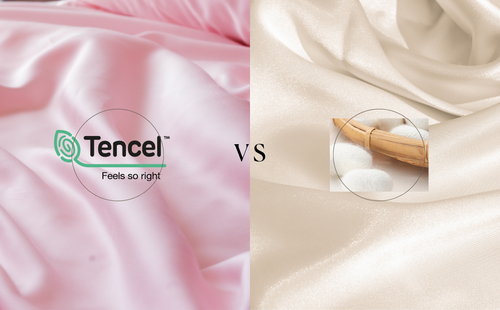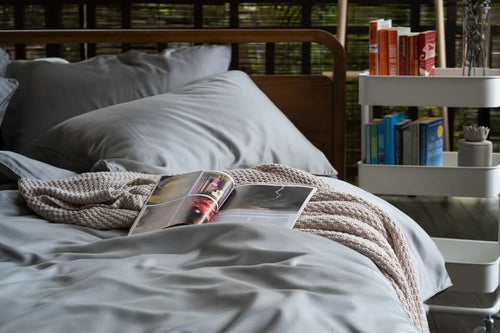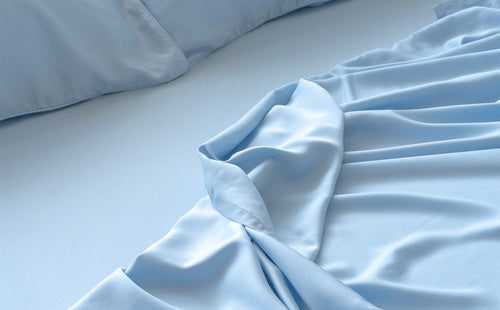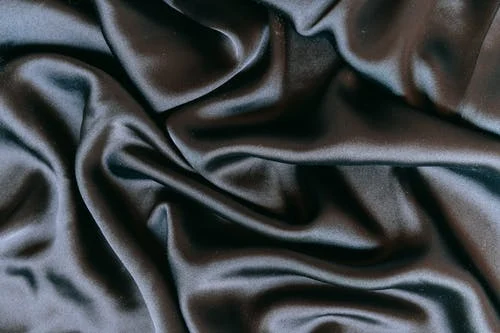At A Glance
Silk and TENCEL™ have shared properties, thus, they are often compared to each other. This post will help you weigh which one is better.
Quick Tips
- Consider the sustainability and ethical production of the material.
- Note that some materials may require more time and effort to care for.
Introduction To TENCEL™ Lyocell And Silk Fibres
Cotton bed sheets, made out of traditional long staple cotton fabrics, would be the classic choice for most people looking to buy bed sheets. However, when it comes to luxury beddings, silk usually comes to mind. These classic choices have been at the top of mind when buying quality bed sheets but alternative materials such as TENCEL™ Lyocell have been emerging as the more ethical and less costly alternative. Here we will be breaking down which premium fabric would be most suitable for your bedding needs.
What Is TENCEL™?
The term TENCEL™ is the name of the brand of fibres manufactured by the Austrian textile company Lenzing AG. Whereas Lyocell is the type of fibre made under the TENCEL™ family of products. This fibre is a semi-synthetic fibre commonly used in the production of bedding and clothing.
Lenzing’s TENCEL™ Lyocell differentiates itself from other TENCEL™ fibres as the latest generation of fibres manufactured by Lenzing AG. This means that TENCEL™ Lyocell fibres are produced with the latest technology such as REFIBRA™ which improves the sustainability of the fibre.

Photo By Artem Podrez From Pexels
What Is Silk?
Silk is a delicate and soft fibre. Raw Silk fibres are protein fibres harvested from the cocoons of the Silk producing Bombyx Mori larvae. The process of harvesting the protein fibres from the cocoons is known as sericulture.

Photo By Quang Nguyen Vinh From Pexels
Sericulture has been carried out since 4000 BC where the larvae of Bombyx Mori, also known as silkworms, are fed on a diet of mulberry leaves until they begin to form cocoons. Once the cocoons of the silkworms are completely formed, they are placed in hot water to extract the protein fibres to form pure silk.
Benefits Of Both Silk And Lyocell
Both silk and TENCEL™ Lyocell fibres share many similar properties, and are often compared between each other and thus putting TENCEL™ in a good position to be offered as a silk alternative. Here are the common benefits both silk and TENCEL™ share.
Benefits Of Silk And It’s Increasing Popularity
Silk pillowcases and bed sheets have become increasingly popular over the past few years.
This is due to the fabric’s ultra-smooth texture which can keep your precious locks from becoming tangled up at night. Unlike most other sheets, silk will not draw moisture away from your body, ensuring that your hair and skin remain hydrated.

Photo By Mathilde Langevin From Pexels
Real smooth silk is a natural material that has low friction between your hair and skin. It also is very breathable and wicks excess oils and moisture away from your face. This not only means that all of the anti-wrinkle, clear skin, and hair benefits are accurate. It also means that these sheets are luxuriously comfortable to sleep on as well.
Both Materials Feel Soft And Smooth
Both TENCEL™ Lyocell and Silk bed sheets are well-known for being soft, smooth and delicate. With a buttery smooth hand feel, it’s more gentle than regular cotton and linen. Making them ideal for babies and those with sensitive skin or allergies.
Both Silk And Lyocell Have Moisture Wicking Properties
Silk has moisture wicking properties, which helps prevent the build up of excess sweat while you sleep. Hence having silk beddings such as silk pillowcases and bed sheets would ensure that you remain cool when you sleep.

Moisture Wicking Process By Russ Clarke-Wildeman
Similarly, TENCEL™ Lyocell also has moisture wicking properties which surpasses that of silk’s. Therefore, TENCEL™ Lyocell and silk are superior choices of fabric when it comes to bedding products in warmer and humid climates such as Singapore as it offers better heat management.
Both Fabrics Have Hypoallergenic Properties
The production processes in Silk and TENCEL™ Lyocell make use of less harmful chemicals. TENCEL™ Lyocell replaces the use of Sodium Hydroxide with a solution of N-Methylmorpholine N-oxide which is an organic compound. This ensures that the production process for TENCEL™ Lyocell is toxin free. Similarly, the production of Silk does not require the use of toxic chemicals.
Since both fabrics do not use any harmful chemicals, they are hypoallergenic. This makes the fabrics ideal for those who have skin conditions or are prone to allergic reactions.
Both Fibres Are Biodegradable
TENCEL™ Lyocell is produced from natural materials and is certified by TÜV Austria Belgium NV to be biodegradable and compostable. For the environmentally conscious, the biodegradability of both materials should give you peace of mind when it comes to the disposal of your old sheets.
Downsides Of Silk And Why TENCEL™ Is A Better Choice
Ethicality
The main raw resource used in the production process of Silk is the larvae of the Bombyx Mori insect. In order to obtain a single pound of Silk, approximately 3.000 silkworms are required. Thus raising ethical concerns behind the production of Silk. To the extent that brands such as ASOS eliminated their use of silk fibres altogether.
On the other hand, the main ingredient for TENCEL™ Lyocell is wood pulp from Eucalyptus trees. Eucalyptus trees are a fast growing plant species. Meaning that they are less prone to overharvesting, making them more sustainable and ethical than silk.
Sustainability
The manufacturing of Silk requires immense amounts of water. To raise a mulberry crop to feed the Silkworm, 1.710.99 litre per kilogram of water is required. The extraction of Silk from Silkworm larvae uses around 445.26 litres per kilogram.

Photo By Rifqi Ramadhan From Pexels
On the other hand, Eucalyptus trees only require 785 litres per kilogram. While the production process of TENCEL™ Lyocell requires minimal amounts of water since its production system recaptures 99.5% of water used. So the water consumption in the production process of TENCEL™ Lyocell requires only 100 litres per kilogram.
This means that the overall production of TENCEL™ Lyocell consumes a lot less water than Silk. Making TENCEL Lyocell sheets are more sustainable than Silk and Cotton sheets.
Care & Maintenance
Silk is extremely delicate and smooth. Although those traits make for desirable qualities in a comfortable bed sheet, it also results in Silk being less durable. On the other hand, TENCEL™ Lyocell is a stronger fabric. This means that it would be durable and resistant to tears and damage. Moreover, the level of care which is required for Silk is much higher than TENCEL™ Lyocell due to its delicacy. Thus the upkeep of Silk sheets is time consuming, making Silk a high maintenance fabric.
Cost
Real Silk is consistently ranked as one of the most expensive fabrics on the market. The high price of Silk is representative of its luxury status. Another reason for the high price of Silk is the high production costs which are passed on to you. TENCEL™ Lyocell is comparatively less pricier when compared to Silk, but price does not define quality. TENCEL™ Lyocell can be considered as a more value for money and lower maintenance alternative to Silk.
Which Should You Choose?
With so many similarities, it begs the question "Are Silk Sheets worth it?"
Silk bed sheets in Singapore were the traditional choice for luxury sheets but TENCEL™ Lyocell seeks to offer an alternative.
Silk bed sheets are smoother and more delicate than TENCEL™ Lyocell bed sheets but it is not without its downsides. Despite the benefits of Silk, it is less environmentally friendly and ethical to produce as compared to TENCEL™ Lyocell.
Additionally it requires more time and effort to care while being more expensive. TENCEL™ Lyocell is also more breathable and offers better heat management than Silk.
TENCEL™ Lyocell is for those who want to own a premium quality material similar to Silk while avoiding paying for the premium price tag associated with mulberry Silk.
Frequently Asked Questions
Is TENCEL™ Lyocell More Expensive Than Silk?
TENCEL™ Lyocell shares similar qualities with Silk while being at a lower price quantum.
Is TENCEL™ Lyocell High Quality?
Lyocell, produced by Lenzing AG, has to meet stringent production standards which ensures the quality of the fibres produced.
Is TENCEL™ Lyocell The Same As Silk?
TENCEL™ Lyocell is not the same as Silk. However, it shares similar qualities with Silk while being at a lower price.
Are TENCEL™ Sheets Suitable For Singapore?
The use of TENCEL™ bed sheets in Singapore, would ensure a greater quality of sleep. TENCEL™ bed sheets would help you sleep cool, which is especially important in the hot and humid climate of Singapore.





































